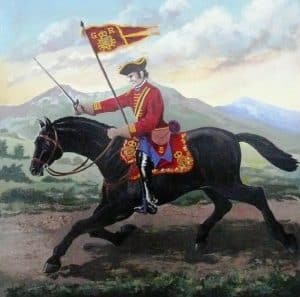The Battle of Dettingen
From 1715 until 1742, The King’s Own Regiment of Dragoons soldiered at home, engaging in nothing more exciting than anti-smuggling duty. The uneasy peace in Europe was broken when the Emperor of Austria died and “The War of Austrian Succession” broke out with Britain and Austria once again fighting France.
This time there was one major battle and one clear result.
King George II was to assume command of his army a week before the battle of Dettingen – the first time that a King of England had been to war since William III led his troops in Flanders.
The army was increased to 62,000 men, of whom 16,000 ultimately sailed for Ostend, during May 1742, with the King’s Own Dragoons among them.
Lord Stair who, until the arrival of the King on the scene commanded the Allied army, planned to advance and incite the French into battle, but King George II, 150 miles away in Hanover, chose to interfere and order otherwise, so that the troops were moved eastwards up the Main, to Aschaffenburg, where there was no forage for the horses and little food for the soldiers. This mistake almost cost the King his army: when he joined them, on June 19, the men were starving and turning to plunder. The French were in control of the left bank of the river and had put up two bridges at Seligenstadt, thus cutting the Allies off from their supplies and magazines at Hanau.
King George II knew he was trapped, and that he would have to fall back on Hanau; but, though intrepid in battle, he was a ditherer in the conference, and he waited a week before ordering his army to retreat.
At one o’clock in the morning of June 27, Marshal Noailles learned that the Allied troops were on the march. He immediately ordered 28,000 men over the two bridges at Seligenstadt, and to take up positions near the village of Dettingen, while another force was to cross the Mail above Aschaffenburg and form up behind the Allies. Thus the plan to smash King George and his army was complete.
The battle of Dettingen began about noon on the same day, June 27. During the four hours of fighting, the King’s Own Dragoons reached a splendid peak in their history.
General Bland allowed three days to pass before he wrote the letter, describing the conflict:
” On the 27th the King gained a battle over the French army, who crossed the River Main between Hanau and Dettingen and cut of our communication from Hanau, from whence we had our provisions and our bread. They afterwards advanced to attack us on the march; on which we immediately drew up in order of battle, all our English infantry – except a brigade of Guards, which made the rearguard … with a part of the Austrians making a second line. The ground was so marrow as not to admit of more than 22 or 23 battalions in front, with some cavalry, of which my regiment was part.”
Soon after the action began, the officer commanding the left wing of infantry asked for some squadrons of cavalry to cover his flank.
” The King’s Own Dragoons were ordered to this important post, where they suffered severely, being exposed three hours to the fire of the French batteries … from their front as well as from the other side of the river … At length the regiment was led forward, and, encountering nine squadrons of Household Cavalry – the elite of the French army – charged these celebrated horsemen with a degree of gallantry truly astonishing — though overmatched with numbers, and nearly surrounded by enemies, The King’s Own Dragoons were seen nobly contending for victory; and mingled in close fight with their antagonists, the swift motion of their glittering sabres showed with what vehemence the gallant troopers fought for the honour of their King and country.”
The famous French Household Cavalry were defeated and they fled from the field. The French infantry, deprived of their cavalry, had to retreat. The battle was won.
The losses of the King’s Own Dragoons at Dettingen were 1 officer killed and 6 wounded; 41 other ranks killed and 100 wounded. 191 of the horses were also killed or wounded.

Thomas Brown of Bland’s King’s Own Dragoons rescues the Guidon at the Battle of Dettingen
During the battle, Private Thomas Brown rescued one of the Regimental standards in glorious fashion.
For his bravery, Thomas Brown was made a Knight banneret on the battlefield by George II, which was the last time a British monarch led his soldiers into battle.
So, just what is a Knight banneret? Basically, it is a knight hastily created on the field of battle in recognition of a sign of bravery.
This was done by tearing off a streamer from a banner and handing it to him as a token of investiture.

